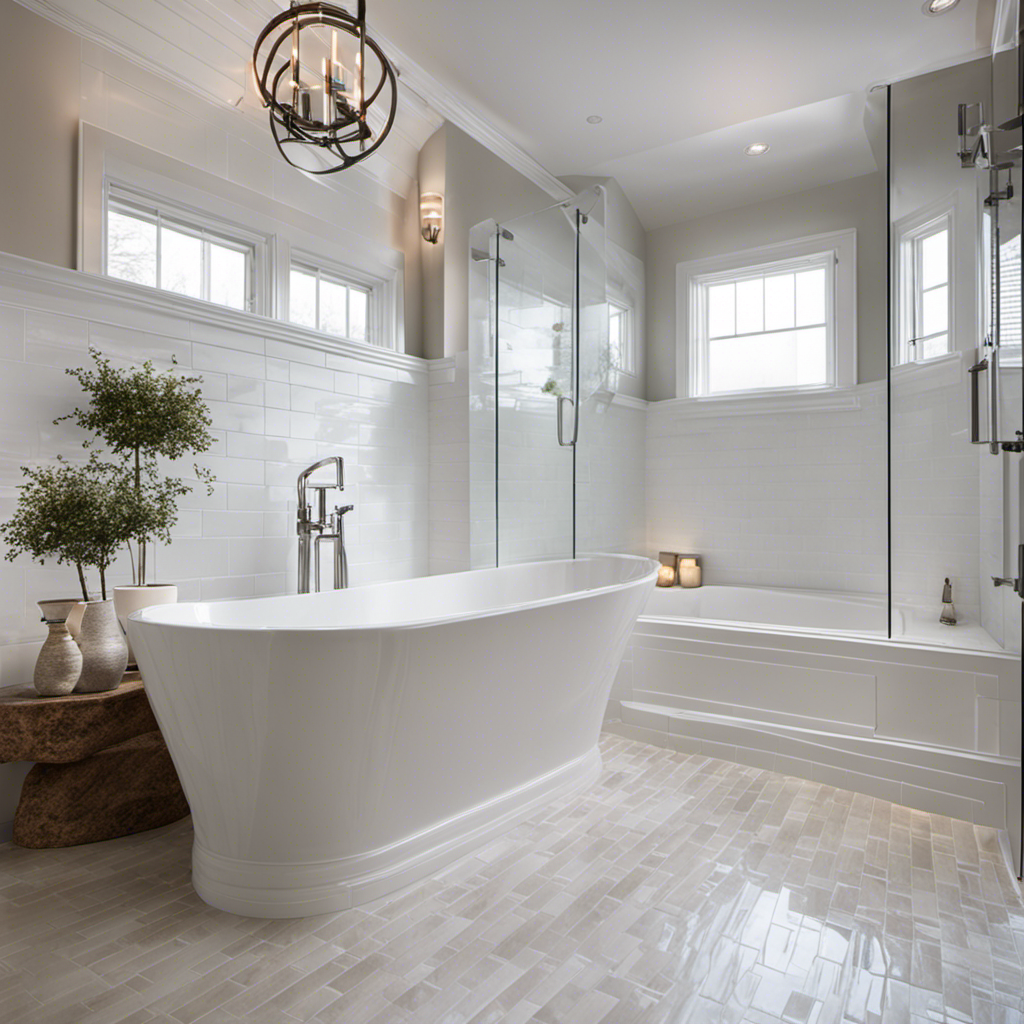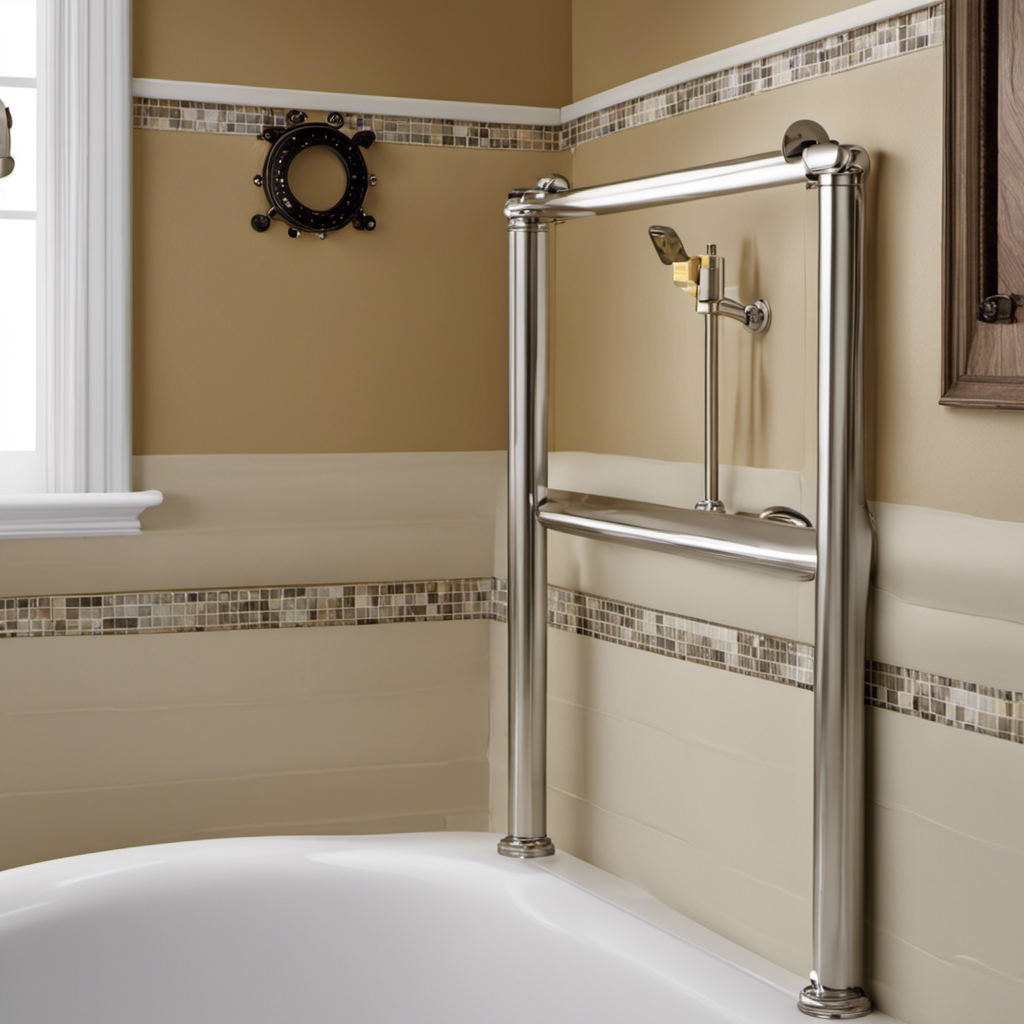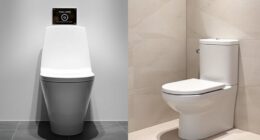I’ve been tiling bathtub walls for years, and let me tell you, it’s a skill worth mastering. In this article, I’ll walk you through the step-by-step process of transforming your plain old walls into a stunning tiled masterpiece.
We’ll start by prepping the surface and gathering all the tools and materials you’ll need.
Then, I’ll show you how to measure and plan the perfect tile layout.
From there, we’ll dive into the nitty-gritty of applying adhesive, installing the tiles, and grouting.
Finally, we’ll finish off with some tips on sealing for a long-lasting and beautiful result.
So grab your trowel and let’s get tiling!
Key Takeaways
- Proper surface preparation is essential before tiling bathtub walls, including removing existing tiles and adhesive, cleaning the walls, and applying a waterproofing membrane or primer.
- Measuring and planning the tile layout is crucial for achieving the desired aesthetic, considering factors such as tile size, shape, and pattern.
- The adhesive or thinset should be applied evenly using the right trowel size and consistency, following the manufacturer’s instructions. Sufficient drying time should be allowed to ensure a strong bond.
- Paying attention to details during tile installation, such as proper alignment, spacing, and grouting techniques, is crucial for a professional finish. Applying a grout sealer and regular maintenance help protect the tiles and maintain their appearance.
Preparing the Surface
Before you start tiling, make sure you’ve properly cleaned and prepped the surface of your bathtub walls. Surface preparation is crucial to ensure a successful tiling project.
Start by removing any existing tiles, adhesive, or grout from the walls. Use a scraper or putty knife to gently scrape away any loose or peeling paint.
Next, clean the walls thoroughly with a mild detergent and warm water to remove any dirt, grease, or soap residue. Once the walls are clean, allow them to dry completely before proceeding.
After the walls are dry, it’s important to apply a waterproofing membrane or primer to prevent moisture from seeping through the walls. This will ensure that your tiles adhere properly and protect the underlying structure from water damage.
With the surface properly prepared, you’re now ready to move on to gathering the necessary tools and materials for the tiling job.
Gathering the Necessary Tools and Materials
First, make sure you have all the tools and materials you’ll need for the job. Choosing the right tile size is crucial for a successful bathtub wall tiling project. Larger tiles can make the space look more open and require fewer grout lines, while smaller tiles can create intricate patterns. Consider the size of your bathtub and the overall aesthetic you want to achieve. Additionally, proper waterproofing techniques are essential to prevent water damage and ensure the longevity of your tile installation. Use a waterproofing membrane or a waterproofing paint-on product to create a barrier between the tile and the wall. This will protect the underlying structure from moisture and potential mold growth. Here’s a handy table outlining the tools and materials you’ll need:
| Tools | Materials |
|---|---|
| Tile cutter | Tiles |
| Trowel | Tile adhesive |
| Notched trowel | Grout |
| Level | Spacers |
| Sponge | Waterproofing |
| Grout float | membrane/paint-on |
Measuring and Planning the Tile Layout
To ensure a successful tile installation, it’s important to carefully measure and plan the layout of your tiles. Measuring accuracy is crucial in order to avoid any mistakes or inconsistencies in the final result.
I recommend using a measuring tape or a laser level to accurately measure the dimensions of the wall and determine the size of the tiles needed. Once you have the measurements, you can start planning the tile pattern selection.
Consider the size and shape of the tiles, as well as the overall aesthetic you are aiming for. There are various patterns to choose from, such as straight, diagonal, herringbone, or even a custom design.
Take your time in selecting the right pattern that will complement your bathroom and create the desired visual impact.
Applying the Adhesive or Thinset
When it comes to applying adhesive or thinset for tiling, there are a few key points to keep in mind.
First, proper adhesive application is crucial to ensure a strong bond between the tiles and the surface. This involves using the right trowel size, spreading the adhesive evenly, and avoiding excessive application.
Second, achieving the right thinset consistency is important for optimal performance. It should be mixed according to the manufacturer’s instructions, with the right amount of water added gradually to avoid lumps or a runny consistency.
Lastly, allowing sufficient drying time for the adhesive is essential to prevent tiles from shifting or sliding. Following the recommended drying time will ensure a durable and long-lasting tile installation.
Proper Adhesive Application
Before you begin applying the adhesive, make sure to properly clean and dry the bathtub walls. This step is crucial for ensuring a strong bond between the adhesive and the walls.
Now, let’s talk about adhesive types and application techniques to help you achieve a professional finish:
-
Adhesive Types:
-
Thinset Mortar: This is the most common adhesive used for tiling bathtub walls. It comes in powdered form and needs to be mixed with water before application.
-
Mastic: Mastic is a pre-mixed adhesive that is easier to work with but may not be suitable for areas prone to moisture.
-
Epoxy Adhesive: Epoxy adhesive is a strong and durable option, but it requires precise mixing and application.
-
Adhesive Application Techniques:
-
Back-buttering: Apply a thin layer of adhesive on the back of each tile using a notched trowel.
-
Comb method: Use a notched trowel to spread adhesive on the wall in one direction, creating ridges.
-
Buttering tiles: Apply adhesive directly onto the back of each tile before pressing it onto the wall.
Remember to follow the manufacturer’s instructions for the specific adhesive you’re using. Happy tiling!
Thinset Consistency and Mixing
Now that we’ve covered the proper adhesive application for tiling bathtub walls, let’s move on to the next important step – thinset consistency and mixing.
Getting the right consistency is crucial for a successful tile installation. To achieve this, start by pouring a measured amount of water into a clean mixing bucket. Then, slowly add the thinset powder while stirring continuously. The aim is to achieve a smooth, lump-free mixture with the consistency of peanut butter. Remember to follow the manufacturer’s instructions regarding water-to-powder ratios.
Additionally, it’s essential to mix only the amount of thinset that you can use within the recommended pot life. This will ensure that the thinset remains workable and adhesive.
Adhesive Drying Time
To ensure a successful tile installation, it’s important to be patient and allow the adhesive to dry completely. Proper adhesive drying techniques are crucial for the longevity and stability of your tiled bathtub walls. Here are some tips to help you achieve the best results:
-
Follow manufacturer instructions: Different adhesives have varying drying times, so it’s important to read and follow the instructions provided by the adhesive manufacturer.
-
Allow sufficient drying time: Rushing the drying process can lead to tiles shifting or even falling off. It’s recommended to wait at least 24 hours before grouting or applying any pressure to the tiles.
-
Use a moisture meter: This handy tool can help determine if the adhesive is fully dry. It measures the moisture content in the adhesive, ensuring that it’s ready for the next step.
By following these adhesive drying techniques, you’ll ensure a successful tile installation.
Additionally, if you’re looking for alternative adhesive options, consider epoxy adhesives or mastic adhesives. Epoxy adhesives offer exceptional strength and waterproofing properties, while mastic adhesives are easy to apply and suitable for small tile installations. Choose the adhesive that best suits your project’s needs and follow the proper drying techniques for the best results.
Installing the Tiles
When it comes to grouting the tiles, it’s important to pay attention to the details. Proper tile alignment is crucial for a seamless and professional finish.
I will share my expert tips and techniques on how to achieve both grouting perfection and precise tile placement.
Grouting the Tiles
First, make sure you have all the necessary grout and tools before starting the process of grouting the tiles on your bathtub walls. Grouting is a crucial step that not only seals the gaps between tiles but also enhances the overall appearance of your bathroom.
Here are some key grouting techniques and grout color options to consider:
- Use a grout float to apply the grout mixture diagonally across the tiles.
- Remove excess grout with a damp sponge, working in circular motions.
- Choose a grout color that complements your tile color, whether it’s a contrasting or matching shade.
- Consider using a grout sealer to protect the grout from stains and moisture.
Properly grouting your bathtub walls is essential for a professional-looking finish. Once the grout has dried, you can move on to the next step: ensuring proper tile alignment.
Proper Tile Alignment
Now that the tiles are properly set and aligned, it’s time to focus on another crucial aspect of tiling bathtub walls – proper tile spacing.
Ensuring the right amount of space between each tile is essential for achieving a professional and visually appealing result. The recommended spacing between tiles is typically 1/8 to 1/4 inch, depending on your personal preference and the size of the tiles.
It’s important to use tile spacers to maintain consistent spacing throughout the installation process. Once the tiles are in place and the adhesive has dried, it’s time to select the right grout color.
The grout color can greatly impact the overall look of your tiled bathtub walls. It’s important to choose a color that complements the tiles and the overall aesthetic of your bathroom.
With proper tile spacing and the right grout color selected, we are now ready to move on to the next step – grouting the tile.
Grouting the Tile
To grout the tile on your bathtub walls, start by mixing the grout according to the manufacturer’s instructions. This step is crucial to ensure the right consistency and durability of the grout. Once the grout is prepared, follow these grouting techniques for a seamless finish:
- Begin by applying the grout diagonally across the tile joints using a grout float.
- Use a damp sponge to wipe away excess grout from the tile surface.
- After 15-20 minutes, when the grout starts to set, use a clean sponge to gently wipe away any haze on the tiles.
When it comes to grout color options, consider the overall aesthetic of your bathroom. Light-colored grout can create a clean and spacious look, while dark-colored grout can add depth and contrast. Choose a color that complements your tile and personal style.
Now that the grout is applied, it’s time to move on to finishing and sealing the tiles.
Finishing and Sealing the Tiles
Once the grout is dry, you can apply a sealant to protect the tiles. Sealing the tiles is an important step in maintaining their durability and appearance.
There are different sealing techniques that you can use, depending on the type of tiles you have. For example, if you have natural stone tiles, you will need to use a penetrating sealant that will soak into the stone and create a protective barrier. On the other hand, if you have ceramic or porcelain tiles, you can use a surface sealant that will create a protective layer on top of the tiles.
To apply the sealant, simply pour it onto the tiles and spread it evenly with a clean cloth or sponge. Make sure to follow the manufacturer’s instructions for the specific sealant you are using. After applying the sealant, allow it to dry completely before using the bathtub.
Regular maintenance tips include cleaning the tiles with a mild detergent and avoiding harsh chemicals that can damage the sealant. By following these sealing techniques and maintenance tips, you can ensure that your tiled bathtub walls stay protected and looking great for years to come.
Conclusion
In conclusion, tiling bathtub walls may seem like a daunting task, but fear not! With the right tools, materials, and a little bit of know-how, you’ll be able to transform your bathroom into a spa-like oasis.
From preparing the surface to grouting and sealing the tiles, each step is crucial in ensuring a flawless finish. So dive in, embrace your inner DIY guru, and let the tiles do the talking.
Get ready to be the envy of all your friends with your magnificent tiled bathtub walls!










